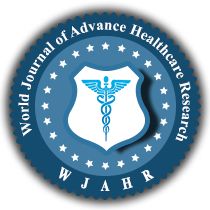| All | Since 2020 | |
| Citation | 105 | 60 |
| h-index | 4 | 4 |
| i10-index | 3 | 2 |
WJAHR Citation 
Login
News & Updation
Best Article Awards
World Journal of Advance Healthcare Research (WJAHR) is giving Best Article Award in every Issue for Best Article and Issue Certificate of Appreciation to the Authors to promote research activity of scholar.
Best Article of current issue
Download Article : Click here
Indexing
Abstract
PDL1 IMMUNOHISTOCHEMICAL EXPRESSION IN NON-SMALL CELL LUNG CANCER AND IT CLINICOPATHOLOGICAL CORRELATIONS
Noor Wasfi Hassoon*, Professor Dr. Hadi Muhammad Ali Almosawi and Professor Dr. Ali Salih Baay
ABSTRACT
Background: Programmed death ligand-1 (PD-L1) is a 33 kDa type 1 transmembrane protein that suppresses the adaptive immune response. Its interaction with programmed death-1 (PD-1) receptor inhibits cytokine production and contributes to immune evasion by tumor cells, playing a significant role in the progression of lung cancer. Objective: This study aimed to evaluate PD-L1 expression in non-small cell lung cancer (NSCLC) patients and its correlation with histopathological grade, tumor type, patient age, and gender. Materials and Methods: A retrospective study with prospective continuation was conducted on 62 histologically diagnosed NSCLC cases over six months at the Babylon Training Center of Pathology. PD-L1 immunohistochemical expression was assessed and scored using the Tumor Proportion Score (TPS). Statistical correlations were analyzed between PD-L1 expression and patient age, gender, tumor type, and histopathological grade. Results: This study comprised 62 NSCLC patients, 77.4% of whom were men, with a mean age of 63.68 years. PD-L1 expression and cancer grade were strongly correlated with squamous cell carcinoma, where all PD-L1-positive patients were moderately or poorly differentiated (p = 0.02). No association was seen between gender and adenocarcinoma grade (p = 0.09). Among the 62 NSCLC cases, 43.5% exhibited PD-L1 positivity. A statistically significant correlation was observed between PD-L1 expression and both patient age and tumor grade, indicating higher expression in older patients and poorly differentiated tumors. Among the PD-L1 positive cases, 63.0% demonstrated low expression, while 37.0% showed high expression. However, TPS levels did not significantly correlate with any of the studied clinicopathological parameters. Conclusion: In NSCLC, PD-L1 expression was highly linked to worse differentiation. Age was significantly correlated, although gender and tumour histological subtype (SCC vs. adenocarcinoma) were not.
[Full Text Article] [Download Certificate]
